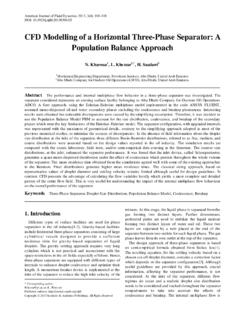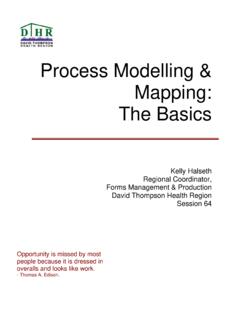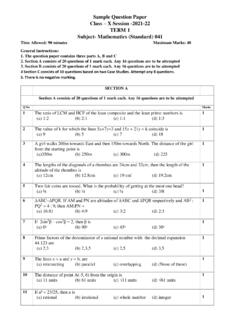Transcription of Introduction to reliability - University of Portsmouth
1 Introduction to reliability ( Portsmouth Business School, April 2012) 1 Introduction to reliability reliability has gained increasing importance in the last few years in manufacturing organisations, the government and civilian communities. With recent concern about government spending, agencies are trying to purchase systems with higher reliability and lower maintenance costs. As consumers, we are mainly concerned with buying products that last longer and are cheaper to maintain, , have higher reliability . The reasons for wanting high product or component or system reliability are obvious: Higher customer satisfaction Increased sales Improved safety Decreased warranty costs Decreased maintenance costs, etc.
2 This document covers The definition and measurement of reliability and failure rates modelling reliability with the exponential distribution Mean time to and before failure The addition and multiplication rules of probability System reliability and fault tree analysis Obviously, we only cover a few of the basics here. For more detail see Besterfield (2013), O Connor (2002), or many other books and websites. There is also a presentation by Professor Ashraf Labib covering asset management, maintenance management and various other practical aspects of the process of managing reliability at It is important to work through the exercises, and check your answers against the notes on the answers at the end of the document.
3 What is reliability The reliability of a product (or system) can be defined as the probability that a product will perform a required function under specified conditions for a certain period of time. If we have a large number of items that we can test over time, then the reliability of the items at time t is given by At time t = 0, the number of survivors is equal to number of items put on test. Therefore, the reliability at t = 0 is R(0) = 1 = 100% 0)(==ttimeattestonputitemsofnumberttimea tsurvivorsofnumbertR Introduction to reliability ( Portsmouth Business School, April 2012) 2 After this, the reliability , R(t), will decline as some components fail (to perform in a satisfactory manner).
4 The failure rate The failure rate (usually represented by the Greek letter ) is a very useful quantity. This is defined as the probability of a component failing in one (small) unit of time. Let NF = number of failures in a small time interval, say, t. NS = number of survivors at time t. The failure rate can then be calculated by the equation: tNNtSF =*)( For example, if there are 200 surviving components after 400 seconds, and 8 components fail over the next 10 seconds, the failure rate after 400 seconds is given by (400) = 8 / (200 x 10) = = This simply means that of the surviving components fail in each second. (You may wonder why the above equation defines (400) and not (410).)
5 The reason is that t is a small time interval, so it is reasonable to assume that the failure rate will not change appreciably during the interval. We then define the failure rate using the beginning of the interval for convenience. In the extreme we can make t infinitesimally small which is the basis of the differential calculus.) We can define failure rates for individual components, and also for complex products like cars or washing machines. In the latter case we need to be clear about what is meant by a failure for a car, for example, these can range from complete breakdown to relatively minor problems. And we should also remember that failures in complex products are generally repairable, whereas this may not be true for individual components.
6 The Concept of the Bath-tub Curve The so-called bath-tub curve represents the pattern of failure for many products especially complex products such as cars and washing machines. The vertical axis in the figure is the failure rate at each point in time. Higher values here indicate higher probabilities of failure. The bath-tub curve is divided into three regions: infant mortality, useful life and wear-out. Introduction to reliability ( Portsmouth Business School, April 2012) 3 Bath tub curve Infant Mortality: This stage is also called early failure or debugging stage. The failure rate is high but decreases gradually with time. During this period, failures occur because engineering did not test products or systems or devices sufficiently, or manufacturing made some defective products.
7 Therefore the failure rate at the beginning of infant mortality stage is high and then it decreases with time after early failures are removed by burn-in or other stress screening methods. Some of the typical early failures are: poor welds poor connections contamination on surface in materials incorrect positioning of parts, etc. Useful life: This is the middle stage of the bath-tub curve. This stage is characterised by a constant failure rate. This period is usually given the most consideration during design stage and is the most significant period for reliability prediction and evaluation activities. Product or component reliability with a constant failure rate can be predicted by the exponential distribution (which we come to later).
8 Wear-out stage: This is the final stage where the failure rate increases as the products begin to wear out because of age or lack of maintenance. When the failure rate becomes high, repair, replacement of parts etc., should be done. Exercises 1 Would you expect the bath tub curve to apply to a car? What about a human being? 2 One thousand transistors are placed on life test, and the number of failures in each time Introduction to reliability ( Portsmouth Business School, April 2012) 4 interval are recorded. Find the reliability and the failure rate at 0, 100, 200, etc hours. (You may find it helpful to set this up on a spreadsheet.) Time interval Number of failures 0-100 160 100-200 86 200-300 78 300-400 70 400-500 64 500-600 58 600-700 52 700-800 43 800-900 42 900-1000 36 Draw a graph to show the change in the failure rate as the transistors get older.
9 Do you think this component shows the bath tub pattern of failure? Draw a graph to show how the reliability changes over time. Measuring reliability To see the level and pattern of the reliability of a product or component in practice, it is necessary to make some measurements. The simplest way to do this is to test a large number of products or components until they fail, and then analyse the resulting data. Exercise 2 above shows how this works. This enables us to estimate the failure rate and reliability after different lengths of time - and decide, empirically, if the bath tub curve applies, or if the failure rate shows some other pattern. There are a number of obvious difficulties which may arise.
10 If the useful life is large it may be not be practical to wait until products or components fail. It may be too expensive to test large samples, so small samples may have to suffice. And for some products ( space capsules) it may be difficult to simulate operating conditions at all closely. There are a number of approaches to these difficulties - most of these are beyond the scope of this unit, but they are discussed in the reading suggested for this session. (An exception is the prediction of the reliability of a product from information about the reliability of its components - this avoids the necessity to test the whole product - which is discussed in a later section of the notes for this session).




